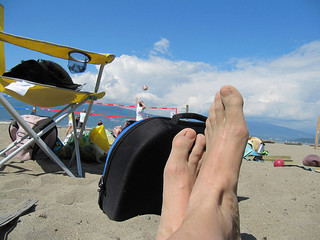
Source: old notes, new purpose, idiolector, Flickr
When you are revising the organization of your persuasive essay, you might not think that your purpose, audience, and the context of your essay enter into the equation. However, all of these factors affect the information you include in your essay and the order in which you present it to your reader. Let’s briefly review these concepts, and then you will complete a couple of activities.
Purpose
Your purpose is the effect you intend to have on your reader. Most commonly, writers write to persuade, inform, and entertain. For example, if you write a letter to the editor of your local newspaper asking that a stop light be installed at a busy intersection, you could choose to write with one of several purposes. You might write the letter to inform your readers about the number of accidents that have occurred at the intersection and hope that some will take action, or you could write an op-ed piece to persuade readers that the stoplight is important for the safety of the community.
Audience
Your audience is the people for whom you are writing. If your appeal to the city council doesn’t succeed in getting a stoplight at the dangerous intersection, you might write a letter to the editor of your local paper. In this case, in addition to using statistics about the dangers of the intersection, you might write a profile of a person whose family member was injured or killed at the intersection. Knowing who your audience is informs your choice of what information to include in your writing.
Context
The context is information that impacts your audience’s understanding of your purpose. For example, perhaps your quest for a safer intersection is prompted by the anniversary of a terrible accident that affected many in your community.
 Using your notes, write what you think the purpose, audience, and context are for the excerpt that follows. It is from the article "How Summer is Making U.S. Kids Dumber and Fatter" written by Peter Orszag for Bloomberg News.
Using your notes, write what you think the purpose, audience, and context are for the excerpt that follows. It is from the article "How Summer is Making U.S. Kids Dumber and Fatter" written by Peter Orszag for Bloomberg News. 
Source: beach volleyball.. birthday party on the beach.. party for my tired feet too.., iwona_kellie, Flickr
It’s July, and for many of us, that brings back fond childhood memories . . . But this quaint notion of summers as a kids’ paradise is dangerously misleading, evidence from social research suggests.
Consider, first, the evidence for the summer fade effect. Taken together, a variety of studies indicate that students' academic skills atrophy during the summer months by an amount equivalent to what they learn in a third of a school year, according to a review by Harris Cooper, a professor of education at Duke University, and several co-authors.
This deterioration, furthermore, varies substantially by income and race, and its impact persists even past childhood. Barbara Heyns, a sociologist at New York University who studied Atlanta schoolchildren in the late 1970s, found that although academic gains during the school year were not substantially correlated with income, summer decline was.
Subsequent studies have replicated the finding. Karl Alexander, Doris Entwisle and Linda Olson of Johns Hopkins University, for example, found that the summer fade can largely explain why the gap in skills between children on either side of the socioeconomic divide widens as students progress through elementary school. Children from all backgrounds learn at similar rates during the school year, but each summer students of high socioeconomic status continue to learn while those of low socioeconomic status fall behind.
The impact is felt even years later. The learning differences that begin in grade school “substantially account” for differences by socioeconomic status in high-school graduation rates and in four-year college attendance, Alexander and his co-authors report.
Sample Response:
The purpose of this piece is to persuade the reader that summer vacation leads to loss of learning and weight gain, but that we can find solutions that don’t do away with summer vacation. The audience is readers of Bloomberg News, especially parents of U.S. schoolchildren, people interested in the year-round school debate—and possibly students worried about losing their summer vacations! The context is the continuing debate over the length of summer vacation and the negative effects it has on student performance.
 Let’s look at another excerpt that appeared in a Research News article “Year-round Schools Don't Boost Learning, Study Finds” written by Jeff Grabmeier. This article responds to the one you just read. After you read the passage, use your notes to write what you think the purpose, audience, and context for the article are. When you are finished, check your understanding to see a possible response.
Let’s look at another excerpt that appeared in a Research News article “Year-round Schools Don't Boost Learning, Study Finds” written by Jeff Grabmeier. This article responds to the one you just read. After you read the passage, use your notes to write what you think the purpose, audience, and context for the article are. When you are finished, check your understanding to see a possible response. 
Source: huh, Dylan Todd, Flickr
Students in “year-round” schools don’t learn more than their peers in traditional nine-month schools, new research has found.
This deterioration, furthermore, varies substantially by income and race, and its impact persists even past childhood. Barbara Heyns, a sociologist at New York University who studied Atlanta schoolchildren in the late 1970s, found that although academic gains during the school year were not substantially correlated with income, summer decline was.
A sociologist at Ohio State University found that, over a full year, math and reading test scores improved about the same amount for children in year-round schools as they did for students whose schools followed a traditional nine-month calendar.
“We found that students in year-round schools learn more during the summer, when others are on vacation, but they seem to learn less than other children during the rest of the year,” said Paul von Hippel, author of the study and research statistician in sociology at Ohio State. The problem with year-round schools may be that they don’t actually add more school days to the 180 typically required, von Hippel said. Instead of a three-month summer vacation, year-round schools typically have several breaks of three to four weeks spread throughout the year. The total number of school days and vacation days remains unchanged, but they are distributed more evenly over the calendar.
Although school districts often adopt year-round schedules to help alleviate overcrowding, some educators have claimed that eliminating the long summer vacation will provide academic benefits for students.
“The results don't support that claim,” von Hippel said.
Sample Response:
The purpose of this article is to persuade the reader that a year-round calendar, or more time at school, is not necessarily better. In fact, sometimes a year-round calendar is the same number of days as a traditional school-year calendar. The audience is readers interested in the year-round school debate. The context of this article is that it responds to Peter Orszag’s article in Bloomberg News This article is also part of the debate about the length of the school year, but it argues the other side of the issue.